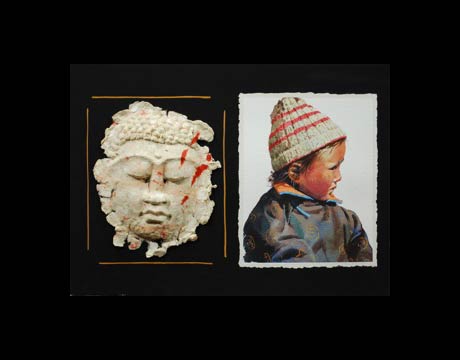Gallery - Past Works - 2010 - Nomad Memoir
(Click image for slideshow)
Once again I returned to India, with three main destinations.
First, I went back to my old stomping grounds in Ladakh to see friends, visit the Kharnakpa nomads at their winter camp in Dat, deep in the Himalaya and to deliver some funds, previously raised in Grey and Bruce counties, for Ladakh's August 2010 flood victims.
After that I returned to Delhi and traveled east to the city of Varanasi on the River Ganges. This is perhaps the most sacred site in the world for Hindu people. I stayed for over a week, observing and documenting the activities along the river ghats. The happenings there, in their totality, can only be described as utterly bizarre; in that the river had the faith based adoration of a billion people and at the same time was one of the most defiled waterways in the world. Below is an excerpt from Varanasi, of a story I wrote about the experience.
he dim light hadn't yet stirred the city, its pilgrims or its car horns. The eye-catching sadhus, the lime-coloured parrots, the swirling kites, the clothes washers and the langur monkeys had yet to appear. Across the river, the early-morning sun, like a quiet ember, squinted through a grey horizon.
The only movement was along the waterfront: three men, silhouetted against the dull sheen of the river, carried a body wrapped in white linen. Awaiting the cargo was a man in a small wooden boat. At the mooring, the men entered the water, lifted and carefully laid the body across the bow. Stiff with rigor mortis, the corpse's head and legs extended out over the sides. With the three men aboard, the boatman leaned forward and pulled back on the oars. Against the river's low illumination and the double-ended boat, the white shroud glowed as if internally lit.
Bamboo oars rubbing against heavy twine stirrups, the lapping of water against a wooden hull and the distant cry of seagulls were the only sounds to be heard. If the four men were talking, it was in whispers.
One hundred metres out, less than a quarter of the way across the river, the rowing ceased and the oars were swung onto the boat. As the vessel slowly drifted in the current, the men stood and turned their attention to their cargo. Together they lifted and pushed the remains, feet first, off the bow. The body entered diagonally with a loud splash. Within a second it lost buoyancy and disappeared. The surrounding water quickly flattened and resumed its reflective nature.
Inside a large city's waterway anywhere else, an offence would have just been committed, probably resulting in a list of charges. Authorities would soon be called, prosecutors assigned, court dates set, perhaps requests for psychiatric tests issued and a community duly horrified. But not here.
This was Varanasi, where the eternal light of Shiva intersects the earth. And this was the Ganges, the daughter of Vedas, where salvation of the soul is granted.
The past forty years--all of my professional life--I've gone to remote places for my work. Inevitably, all theses locales had two things in common: large doses of wilderness and small numbers of people.
Although that milieu seemed to fit me, over the last few years I had begun to ponder a different direction. What if I went the other way, to the other extreme--to what I had avoided--to an environment that was dominated, if not overwhelmed, by people? I wondered what I would say.
Viscerally, the prospect of "working" on the Ganges, in one of the most populous places on Earth, for me was as unnerving as tenting among hungry polar bears. Yet somehow Varanasi had attracted me long before I came, with a car-wreck kind of fascination--both pulling and repulsing me.
(Varanasi is one of nine autobiographical short stories in my upcoming book, The Memory of Water.)
:: BACK TO GALLERY






